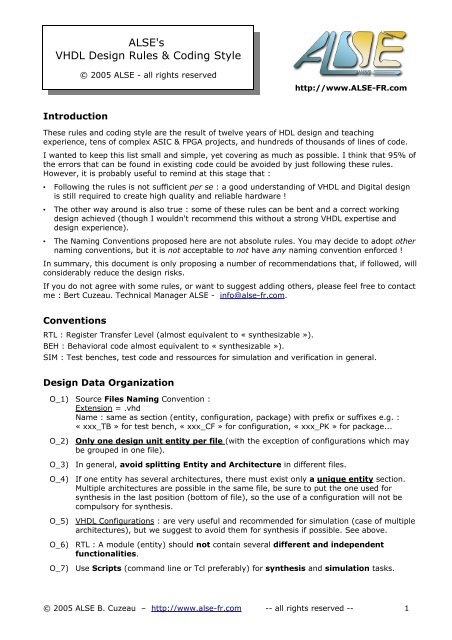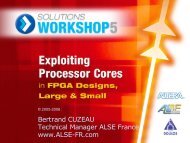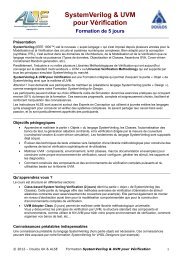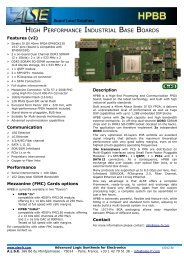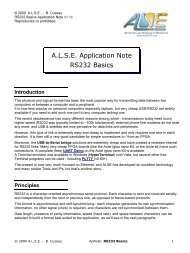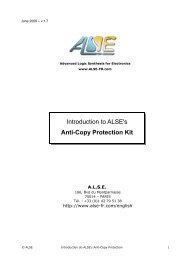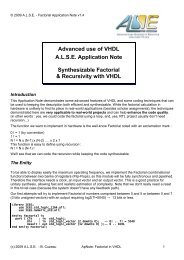Design & Coding Style Guide - ALSE
Design & Coding Style Guide - ALSE
Design & Coding Style Guide - ALSE
Create successful ePaper yourself
Turn your PDF publications into a flip-book with our unique Google optimized e-Paper software.
<strong>ALSE</strong>'s<br />
VHDL <strong>Design</strong> Rules & <strong>Coding</strong> <strong>Style</strong><br />
© 2005 <strong>ALSE</strong> - all rights reserved<br />
http://www.<strong>ALSE</strong>-FR.com<br />
Introduction<br />
These rules and coding style are the result of twelve years of HDL design and teaching<br />
experience, tens of complex ASIC & FPGA projects, and hundreds of thousands of lines of code.<br />
I wanted to keep this list small and simple, yet covering as much as possible. I think that 95% of<br />
the errors that can be found in existing code could be avoided by just following these rules.<br />
However, it is probably useful to remind at this stage that :<br />
• Following the rules is not sufficient per se : a good understanding of VHDL and Digital design<br />
is still required to create high quality and reliable hardware !<br />
• The other way around is also true : some of these rules can be bent and a correct working<br />
design achieved (though I wouldn't recommend this without a strong VHDL expertise and<br />
design experience).<br />
• The Naming Conventions proposed here are not absolute rules. You may decide to adopt other<br />
naming conventions, but it is not acceptable to not have any naming convention enforced !<br />
In summary, this document is only proposing a number of recommendations that, if followed, will<br />
considerably reduce the design risks.<br />
If you do not agree with some rules, or want to suggest adding others, please feel free to contact<br />
me : Bert Cuzeau. Technical Manager <strong>ALSE</strong> - info@alse-fr.com.<br />
Conventions<br />
RTL : Register Transfer Level (almost equivalent to « synthesizable »).<br />
BEH : Behavioral code almost equivalent to « synthesizable »).<br />
SIM : Test benches, test code and ressources for simulation and verification in general.<br />
<strong>Design</strong> Data Organization<br />
O_1) Source Files Naming Convention :<br />
Extension = .vhd<br />
Name : same as section (entity, configuration, package) with prefix or suffixes e.g. :<br />
« xxx_TB » for test bench, « xxx_CF » for configuration, « xxx_PK » for package...<br />
O_2)<br />
O_3)<br />
O_4)<br />
O_5)<br />
O_6)<br />
O_7)<br />
Only one design unit entity per file (with the exception of configurations which may<br />
be grouped in one file).<br />
In general, avoid splitting Entity and Architecture in different files.<br />
If one entity has several architectures, there must exist only a unique entity section.<br />
Multiple architectures are possible in the same file, be sure to put the one used for<br />
synthesis in the last position (bottom of file), so the use of a configuration will not be<br />
compulsory for synthesis.<br />
VHDL Configurations : are very useful and recommended for simulation (case of multiple<br />
architectures), but we suggest to avoid them for synthesis if possible. See above.<br />
RTL : A module (entity) should not contain several different and independent<br />
functionalities.<br />
Use Scripts (command line or Tcl preferably) for synthesis and simulation tasks.<br />
© 2005 <strong>ALSE</strong> B. Cuzeau – http://www.alse-fr.com -- all rights reserved -- 1
Cosmetic (yet important) Rules<br />
P_1)<br />
P_2)<br />
P_3)<br />
P_4)<br />
P_5)<br />
P_6)<br />
P_7)<br />
P_8)<br />
Every design file must be properly documented in a standardized header including at<br />
least : actual file name, Title & purpose, Author, Creation Date, Version, simple<br />
Description, Specific issues, Speed and Area estimates if applicable, tools names and<br />
versions used, HDL standard followed, Revisions & ECOs.<br />
The files must not include any « hard tab » (HT) but only soft spaces, and must be<br />
properly aligned and indented. In case of mess, use Emacs VHDL mode's beautifier !<br />
Total line length should be less than 132 characters.<br />
Only one single executable statement per line.<br />
This rule is important for simulation and debug.<br />
The VHDL code must include significant and value-adding comments, in English.<br />
Every process or continuous assignment should be preceded by a comment<br />
summarizing its purpose.<br />
It should be easy to match the requirements and the HDL code, both ways.<br />
The comments and header information must be kept accurate and up-to-date<br />
throughout code changes and design iterations.<br />
There should be no piece of code commented out.<br />
Inactive or wrong code should be deleted. If needed, an older version of the architecture<br />
can be kept as a reference, for comparison or non-regression purpose.<br />
Naming Rules<br />
N_1)<br />
N_2)<br />
N_3)<br />
Adopt (System)Verilog-friendly Identifiers, OS-friendly names for design units,<br />
always restrict yourself to using plain 7-bits Ascii (avoid accents) and adopt meaningful<br />
names (in English).<br />
Avoid too short names (like « i », « n »...) except for very short scope since they tend<br />
to be difficult to locate with a text editor.<br />
Use Short identifiers when the scope is local, and Longer more explicit (English)<br />
identifiers for greater scope or global items.<br />
N_4) Use the « _t » suffix for types and sub_types, like :<br />
subtype Byte_t is std_logic_vector (7 downto 0);<br />
N_5)<br />
Use Upper and Lower cases for improved readability e.g. LocalReadEnable.<br />
N_6) Avoid using 1 (one), l (lower case L), I (uppercase i) O (uppercase Oh) and 0<br />
(zero) in situations that may be visually ambiguous.<br />
N_7)<br />
N_8)<br />
N_9)<br />
Use meaningful and conventional names for architecture kinds like : "RTL",<br />
"Behavioral", "Structural","Test", in the appropriate context.<br />
Adopt a unique notation for active low signals (like nCS or CS_n for example, but<br />
not both).<br />
Define internal signals with a derived name when you need to read back output<br />
Signals (for example OutBus_i for OutBus).<br />
N_10) Use instance names derived from the entity names. For example :<br />
Fir16x8_i Fir16x8 port map ( etc...<br />
N_11) Do not use too long names for identifiers, especially for entities.<br />
Try a maximum of 8 characters, and at least no more than 16, identical with the file<br />
name.<br />
N_12) Name Clocks : CLKxxx, Resets : RSTxxx...<br />
N_13) Do not use extended identifiers.<br />
© 2005 <strong>ALSE</strong> B. Cuzeau – http://www.alse-fr.com -- all rights reserved -- 2
<strong>Coding</strong> Rules<br />
C_1)<br />
C_2)<br />
C_3)<br />
C_4)<br />
C_5)<br />
C_6)<br />
C_7)<br />
C_8)<br />
C_9)<br />
Adopt VHDL 93 / 2001 standard (VHDL '87 was messy and is definitely obsolete).<br />
RTL : Use exclusively IEEE libraries : std_logic_1164 & numeric_std.<br />
Do NOT use Synopsys' : std_logic_arith, std_logic_(un)signed, numeric_bit,<br />
and other horrendous and proprietary libraries...<br />
Math_real should be avoided if possible in RTL code (but becomes more and more<br />
acceptable over the years).<br />
BEH & SIM : use also textio (ieee) and std_logic_textio (synopsys).<br />
Math_real is also possible and useful, recommended in test benches.<br />
Using specific non-standard packages and libraries should be limited to a strict<br />
minimum and with great care since this weakens the project's integrity, safety,<br />
portability and reusability.<br />
RTL + BEH : define only one single port per line + a comment for every port.<br />
RTL : Use exclusively std_logic (and std_logic_vector) types in ports.<br />
Avoid all other types like : (un)signed, integers, booleans, reals, multidimensional<br />
arrays, records, enumerations... This rule can not be bent on the top level !<br />
(all types are indeed okay for BEH, SIM)<br />
Unconstrained arrays can be used in ports (very elegant style), but this can cause<br />
trouble for unitary synthesis (always), and synthesis (not all synthesizers, at the time of<br />
writing, do support unconstrained array in ports).<br />
Default values can be used for input ports.<br />
RTL : records are possible and sometimes recommended for inter-entity connectivity,<br />
but should be avoided in top level ports.<br />
C_10) Vectors directions :<br />
1. Use descending (downto) if the vector represents a number (or when in doubt...).<br />
2. Use ascending (to) for the first dimension of a memory array, for example :<br />
array (0 to 15) of std_logic_vector (7 downto 0)<br />
3. Ascending is also okay for a numbered collection of items, like LED array etc...<br />
LEDS : std_logic_vector (1 to 8);<br />
C_11) RTL : Avoid hard values and numeric constants, use attributes on objects or explicitly<br />
declared constants instead.<br />
Y
C_16) RTL : "wait" must not be used.<br />
C_17) RTL : Avoid using attributes on types, prefer the attributes on objects (signals or<br />
variables).<br />
C_18) RTL : Do not use "BUFFER" mode in ports.<br />
Use « out » mode + internal signals with proper naming convention (see N9) and<br />
suitable type. If different type, convert in the continuous assignment.<br />
C_19) RTL : Do not use "INOUT" mode except at the very top level.<br />
Define the tri-state drivers only at the top-level of the hierarchy, thus avoiding to rely on<br />
"tri-states bubble-up". Remember that internal tri-states are strictly forbidden (in most<br />
FPGA architectures) or non portable if allowed in the technology.<br />
C_20) RTL : the tri-state and bi-directional Input/Outputs must be coded in the top level as :<br />
ExtBus 'Z');<br />
BusIn
C_36) RTL : You must not initialize signals at their declaration.<br />
You must not initialize variables at their declaration in processes.<br />
It is acceptable to initialize variables at their declaration inside functions.<br />
C_37) RTL : Avoid using procedures in RTL code. This is technically possible, but there is no<br />
real advantage for doing so, and the code may become more difficult to understand.<br />
Using functions in RTL is possible. The trefer functions declared in the architecture<br />
(local) rather than in packages (too far) or in the process (too local).<br />
C_38) BEH & SIM : Definitely use procedures as much as possible.<br />
C_39) RTL : Preferably code combinational logic inside sequential processes.<br />
C_40) RTL : Avoid combinational processes if possible (see above).<br />
In case : Sensitivity Lists must be complete and accurate (no missing, no extra).<br />
C_41) BEH & SIM : Avoid processes with sensitivity list, use the « wait » style instead.<br />
C_42) BEH & SIM : Inside the processes, make sure there is a wait or equivalent in every<br />
branch !<br />
C_43) RTL : Ressource sharing. Document (with appropriate comments) the intended<br />
operators that synthesis is expected to share. In case of doubt, remove the operator(s)<br />
and factor it (them) out « by hand » (like in continuous assignments).<br />
C_44) RTL : Use as few proprietary (vendor-specific) macro-functions as possible and<br />
properly isolate / document them. When possible, inference may be preferable, but this<br />
depends on many design- vendors- and tools-specific factors.<br />
C_45) RTL : One single clock domain per entity (except on top level and clock domainresynchronization-<br />
crossing entities indeed !).<br />
Signals are not allowed to cross domains without proper resynchronization !<br />
C_46) RTL : All asynchronous input signals should be re-synchronized, preferably at the<br />
top-level. Do not insert logic between the I/O and the input Flip-Flop !<br />
You may decide to use two FlipFlops to resynchronize and thus take care of possible<br />
metastability issue.<br />
Synchronous I/Os must be handled specifically (timing constraints etc...).<br />
C_47) RTL : All the Entity's outputs should be registered.<br />
Combinational outputs can also create combinational feedbacks through the hierarchy.<br />
C_48) RTL : At the top level, combinational outputs should not be allowed.<br />
In general, all the device's outputs should be direct Flip-Flop outputs.<br />
Avoid relying on « not gate push back ».<br />
C_49) RTL, BEH, SIM : Avoid active-low signals inside the design.<br />
The internal logic should be active-high.<br />
C_50) RTL : Finite State Machines <strong>Coding</strong> <strong>Style</strong>.<br />
Please contact <strong>ALSE</strong> (info@alse-fr.com) for our recommendations and Application Note.<br />
C_51) RTL : Isolate unavoidable technology-specific code (internal tri-states, memory<br />
inference / instanciation, primitives instanciations like PLLs, etc...<br />
C_52) RTL : Complex entities or technology-specific instances must have a behavioral<br />
model, for simulation (or faster simulation).<br />
C_53) RTL, SIM, BEH :<br />
Place documented assertions (VHDL, OVL, or PSL) where appropriate.<br />
Refer to ABV methodology.<br />
C_54) SIM : At the end of the simulation, the simulator should stop due to events starvation,<br />
to avoid useless simulation runs (beyond stimulus range).<br />
The clock must therefore be stopped (as well as other stimuli not depending on clock).<br />
© 2005 <strong>ALSE</strong> B. Cuzeau – http://www.alse-fr.com -- all rights reserved -- 5
<strong>Design</strong> Flow<br />
F_1)<br />
F_2)<br />
F_3)<br />
F_4)<br />
F_5)<br />
F_6)<br />
F_7)<br />
F_8)<br />
Use Scripts (command line or Tcl preferably) for synthesis and simulation tasks.<br />
Use GUIs when investigating, or other early phases.<br />
A finalized design should never rely on any GUI.<br />
Test Benches must be self-checking and regressionnable.<br />
They should avoid using not-portable run-time « simulator » commands (like force,<br />
unforce, etc...).<br />
Test benches, auxiliary files (vectors, expected results, memory contents, behavioral<br />
models, etc...) should be versioned, properly documented and archived.<br />
Every step involved in producing the final object (usually the bitstream) must be<br />
automated through documented, versioned and archived scripts.<br />
The steps must be documented since the scripts are tool-specific and version-specific.<br />
Every entity must be white-box tested (unitary) with (at least) one Test bench.<br />
Every entity must be unitary synthesized (very simple entities may violate this rule).<br />
The design must be simulatable at post-layout timing level.<br />
The exact Type and Version (including Services Pack info) of all the Tools used must<br />
be properly documented. On some key projects, it may be desirable to maintain the<br />
availability of all the tools used throughout the life of the product.<br />
-=oOo=-<br />
Note : these rules are intended to be used by the delegates who followed our VHDL Training<br />
Courses (where all the proper concepts are taught and the rules are explained).<br />
If you are interested by these Training Courses, please contact us at :<br />
info@alse-fr.com<br />
Advanced users may decide that some rules could be bent. Our experience suggests that this is<br />
possible, but also that it should be done in a very controlled and documented way. An example is<br />
the initialization of signals at their declaration, which is supported by a few synthesis tools and<br />
some FPGA families, but definitely not all (so we still recommend keeping our rule).<br />
© 2005 <strong>ALSE</strong> B. Cuzeau – http://www.alse-fr.com -- all rights reserved -- 6


